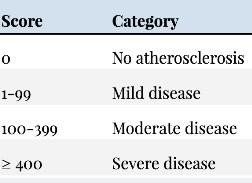Coronary artery calcification (CAC) scans shine light on a subset of the population: those without typical clinical evidence of disease (i.e., those who have not already had a heart attack, stent, or bypass surgery. Think of this as a risk stratification tool that identifies your risk of heart disease.
Coronary artery calcification (CAC) occurs often with the buildup of plaque and calcium in the arteries of the heart, which can cause blood vessels to narrow and lead to the development of heart disease.
The risk factors for coronary artery calcification are the same as for coronary artery disease. These risk factors include:




Symptoms from CAC come due to significant blockage of the arteries of the heart. Some people can be completely asymptomatic, while others may experience



A calcium-score screening heart scan is a type of CT scan that picks up calcium deposits in the arteries of your heart. It’s also known as a coronary calcium scan (CAC scan) calcium score test or a cardiac CT for calcium scoring.
Before the scan begins, the technician attaches sensors, called electrodes, to your chest. These connect to an electrocardiogram (ECG or EKG), which records your heart activity during the exam and coordinates the timing of X-ray pictures between heartbeats when the heart muscles are relaxed.
During the heart scan, you lie on your back on a movable table, which slides into the tubelike CT scanner. Your head is outside the scanner the whole time. The exam room will likely be cool.
You’ll be asked to lie still and hold your breath for a few seconds while the pictures are taken. The technician operates the scanner from a room next door but can see and talk to you the entire time. The entire procedure should take about 10 to 15 minutes.
No special precautions are needed after having a heart scan. You should be able to drive yourself home and continue your daily activities.
The result of the test is usually given as a number called an Agatston score. The score reflects the total area of calcium deposits and the density of the calcium. CAC score results fall into four categories which correlate with the severity of disease and range from no disease to severe disease.
Importantly, and discussed in more detail below, soft plaques can escape detection using a CAC scan. A low to zero CAC score suggests a lower risk of future events, but it does not mean a zero risk of future events.

When we talk about CAC, we like to use an analogy of atherosclerosis as a crime scene involving breaking, entering, and vandalizing. A backward-looking test will tell you if anyone has tried to break into your home. A criminal went into your house while you were on vacation and did some damage to your home, damage that was somewhat irreparable in that you couldn’t repair your home back to a state where you never would’ve known there was a break-in. Holes in the walls of your home needed to spackle to patch them up. The repair work left clues of damage. In the case of atherosclerosis, a lesion is a damaged artery, and the calcium deposits are a sign of repair to the artery.
A CAC score above zero tells you that there’s been a bad enough break-in to require repair. However, a lot can go on in the disease process leading up to that point that goes unnoticed by a CAC scan. Additionally, a CAC scan does not necessarily identify the plaques that might do the most damage.
The CAC score predicts events independently of standard risk factors and is better than the commonly used Framingham risk score in the prediction of cardiovascular events. To get a sense of the absolute risk, look at the event rates in this table.

We will communicate your results to you, and depending on the outcome, one or more of the following strategies may be needed: